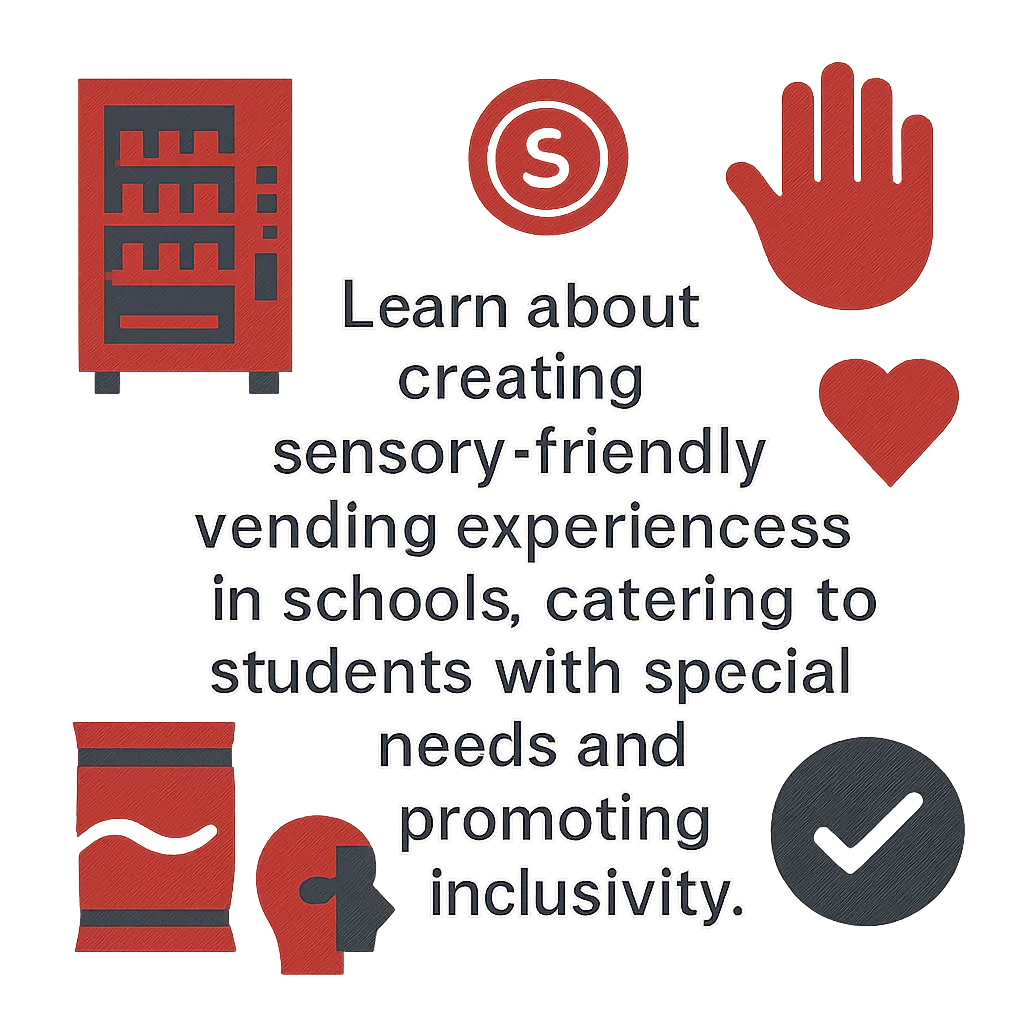Sensory-Friendly Vending for Schools
Learn about creating sensory-friendly vending experiences in schools, catering to students with special needs and promoting inclusivity.
Back to Vending for Schools ResourcesLearn about creating sensory-friendly vending experiences in schools, catering to students with special needs and promoting inclusivity.
Back to Vending for Schools ResourcesSensory-friendly vending in schools is designed to provide comfortable access to snacks and drinks for students with sensory sensitivities, fostering a more inclusive environment.
![]() Minimizes loud noises and bright lights common in traditional machines
Minimizes loud noises and bright lights common in traditional machines
![]() Offers a calm and predictable experience for sensitive students
Offers a calm and predictable experience for sensitive students
![]() Promotes inclusivity by making vending accessible to everyone
Promotes inclusivity by making vending accessible to everyone

Schools are dynamic environments, and for some students, the sensory input can be overwhelming. Traditional vending machines, with their bright lights, loud dispensing noises, and sometimes strong food odors, can inadvertently create barriers for students with sensory sensitivities, including those with autism, ADHD, or other learning differences. Implementing sensory-friendly vending solutions is a thoughtful step towards creating a more inclusive and supportive school community, ensuring all students can access refreshments comfortably.
Creating a sensory-friendly vending experience involves careful consideration of machine design, placement, product selection, and operational aspects. Quiet-running machines, often newer models with advanced mechanics, are paramount. These machines minimize the clanging and whirring sounds that can be startling. Similarly, reducing overly bright or flashing LED lights can help prevent visual overstimulation. Some modern units even feature muted displays and gentle illumination.
Beyond the machines themselves, product selection plays a crucial role. For sensory-friendly vending, schools should consider offering items with mild or neutral flavors and scents, avoiding strong or artificial odors that can be off-putting. Clear packaging can also be beneficial, allowing students to visually confirm their choice without surprises. It's an opportunity to align with healthy snack policies for schools by offering nutritious choices that are also sensory-conscious, ensuring students have access to options they will feel comfortable consuming.
The location of vending machines within a school environment significantly impacts their sensory footprint. Placing machines in quieter zones, away from high-traffic corridors or direct sunlight, can mitigate sensory overload. Creating a "vending nook" with a slightly softened environment—perhaps with a small, designated space or a decorative screen—can offer a sense of calm. Embracing touchless vending for schools can further enhance the experience, reducing the need for direct physical contact and minimizing potential germ concerns, which can also be a sensory issue for some students.
Modern vending technology offers various features that contribute to a sensory-friendly environment. Touchless payment options, such as card readers or mobile pay, eliminate the need for fumbling with coins or bills. Machines with clear digital interfaces and simple, intuitive selection processes reduce cognitive load. Innovative solutions like AI vending coolers in schools can offer a visually appealing, silent, and seamless selection process, often without the typical mechanical operations of traditional machines. By embracing these advancements, schools can provide refreshment access that respects and supports the diverse sensory needs of their student body.
Sensory-friendly vending focuses on creating a calm, inclusive experience for students by minimizing common sensory triggers like loud noises, bright lights, and strong smells from vending machines.
It ensures that all students, especially those with sensory sensitivities or special needs, can comfortably access snacks and beverages without feeling overwhelmed or distressed.
Triggers include loud operational noises (dispensing, coin mechanisms), flashing lights, strong food odors, and crowded vending areas.
Opt for modern machines designed for quiet operation, place them in less trafficked areas, or use sound-dampening panels around the vending zone.
Focus on products with mild or no odors, offer clear packaging for visual transparency, and provide an inclusive selection with diverse textures and flavors.
Yes, avoid machines with overly bright or flashing lights. Consider softer, consistent lighting in the vending area to create a more soothing atmosphere.
Utilize vending machines with cashless payment options (card, mobile pay) and touchless selection features to minimize physical interaction and germ concerns.
Newer, quieter models with digital interfaces, subdued lighting, and smooth dispensing mechanisms are often preferred. AI vending coolers can also be a great fit.
Conduct surveys or focus groups with students, special education staff, and parents to gather feedback on preferences and potential triggers.
Absolutely. Schools can stock sensory-friendly machines with a wide variety of healthy, compliant snacks and beverages that also meet sensory considerations.